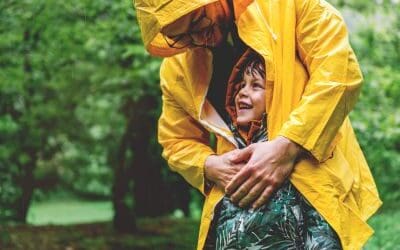A lot of children are isolated at home at the moment using their mobiles and the internet – a recipe for increased exposure to online abuse which early statistics are supporting.
As a mum, I am extremely passionate about child protection. So much so that eight years ago, along with my husband, we committed to do something about it. We started a consent-driven business focused on image management protection for children and I’ve thrown myself into the topic of privacy.
I often reflect on what drove this passion to give children and their parents greater control over their online images: was it because I experienced my own private childhood, or have I just heard too many gut-wrenching stories on what can go wrong for a child these days online? Probably both factors influenced me. But the simple answer is that when I became a parent, I strongly believed I had a duty to protect my child (and other children), wherever, whenever I could. Kids are now exposed to a world where unfettered and unfiltered image proliferation has never been easier, especially images featuring them, and the level of harm (physical and mental) that can be done through the simple sharing of photos and videos seems to have no boundaries.
Even with the best intentions, individuals and businesses alike can inadvertently make decisions when choosing to share images featuring children that can have far reaching consequences, many impossible to reverse. Twenty years ago, the threats of harm in the physical world were evident and tangible, and good safe practices could be defined in simple actions like: wear a seatbelt, don’t go out in the dark on your own, latch cupboards, lock the front door, cover power sockets and teach kids about “stranger danger”. Today, online risks are not so easy to identify.
Every image released online is regarded as ‘published’ content and increases the digital footprint of a child (and others in it) on a global scale. Aside from the visual subject, the amount of data carried in an image, often unknowingly (through metadata and details in a photo), and the broad global reach made possible given the extraordinary adoption of social media, ensures that the impact and after-effects are multiplied astronomically. And not everyone is who they appear to be or has good intentions.
Why is consent so important?
Sharing photos and videos online is more than just sharing a pretty picture – they provide markers of your life online (who you are, what you look like, where you were, when you were there, whom you were with, and more). And a digital trail becomes a permanent part of your online identity, lasting much longer than your living self…perhaps for eternity. The problem is that it is difficult and impossible to know how these images and online footprints will be used in the future. That’s why it is so important to get control early on.
For someone who thankfully had an ‘unpublished’ childhood, I wanted to ensure my daughter had a similar experience even with a digital world at play. When she started school, however, if we did not agree to signing a blanket photo consent form and allow the school to share her photo on social media, she could not participate in normal school activities. Although I religiously hand wrote on each form – as there was never an option to opt out! – that I did not want my child’s photo shared on social media, I had to trust that the school would read and follow my instructions. Sadly, that did not happen. When their actions started to hurt my child emotionally, I had to bring it to the attention of the school Principal, but found they simply did not have the mechanisms in place to help. I kept asking myself (and the school), “how is social media allowed to affect my child’s experience at school?” and “why is no one doing anything about this problem?”.
The act of a parent providing their image consent – when collected correctly – is the only true way a parent can control how their children’s images captured by an organisation can be used and shared publicly; be it a school, club, gymnastics, swimming, drama or dance school. If done properly, image consent is collected voluntarily, is informed, current and specific. Sadly, this has not been the case at many of the organisations my child has been a member (such as soccer club and drama school), and unless more parents start speaking up about the way consent is collected for permission to use, publish and share images of children, nothing will change.
Consent also does not mean collecting only at one point in time, on enrollment, with no opt-out option. For example, “If you don’t agree to us using your child’s photo from day one until the day they leave, your child cannot join”. Or using bundled forms where other consents are added in. For example, a single form where you are asked to tick one box to agree to the organisation using your child’s photo for absolutely every purpose, and another box to say your child has allergies.
What is our role as parents if not to nurture and protect our young?
The risks (realised or unrealised) associated with interacting in a digital world – which by the way is only 20 years young – is not as entrenched or established in our minds like the risks or threats associated with the physical world.
It is even more important right now that every parent takes responsibility for their child’s digital footprint and how their images are used until they are old enough and mature enough to make such decisions on their own. Consenting age can vary by child, but you really cannot expect a two-year-old to give consent and understand what they are consenting to – even when it comes to photo taking. They really have no understanding of the consequences or risks that can result from making such a decision. Heck, they likely cannot say the word, let alone spell it!
Neurologists say that below the age of 10, and especially under the age of four years (see table reference below), cognitive abilities to make decisions are in early stages of development. The rise of adolescence plays an important influence in decision-making confidence, but not always for the better. For example, a teenage brain is more wired to risk-taking. All these factors must be taken into consideration before asking consent of a child.
For a child to make complex decisions, they must have a capacity to understand, express choice, undertake reasoning and have a sense of appreciation. All these factors must be taken into consideration before handing over any adult level decision-making responsibility, like decisions around privacy and consent.
At this time, its critical parents stay true to the meaning of guardianship.
5 things every parent should do to protect their child’s images
Given my dual status as both a parent and image privacy professional, I want to share my top 5 simple steps I have used when it comes to protecting a child’s images online to help other parents:
- Recognise and remain committed to being the custodian of your child’s image consent until you believe them mature and savvy enough to make their own decision.
- Take a position by educating yourself about image sharing risks, privacy and consent, and decide how you want to manage your child’s digital footprint when they are a baby, toddler, tween, teenager.
- Make your stance known to your child, family, school, friends, any other parents in your child’s circle so they are aware and can support your stance.
- Accept no variations from the plan and as they get older, sit down and set-up a plan with your child so they are fully aware of the plan and in agreement. I did this with my daughter when she was 10 (around the same time a mobile phone came into her life).
- Be vigilant by regularly checking-in with your child, and search online to see how your child’s footprint is going, making corrections where potential harm is possible.
I’m certain that in decades to come, all of this will seem as simple and normal as teaching our children to cross the road safely, if we start taking action now.
I am the Chief Operations & Marketing Office at pixevety. If any of what I have shared today resonates and you’d like to discuss further, feel free to connect with me on LinkedIn. I’ll keep posting regularly with my ‘parent’ hat on and look forward to sharing more ways we can keep privacy a reality for our children.




